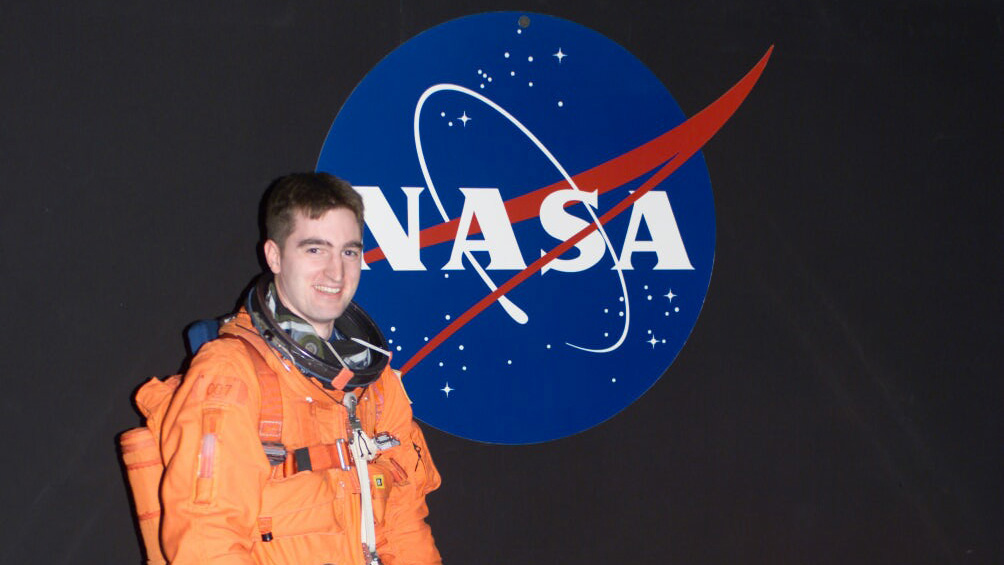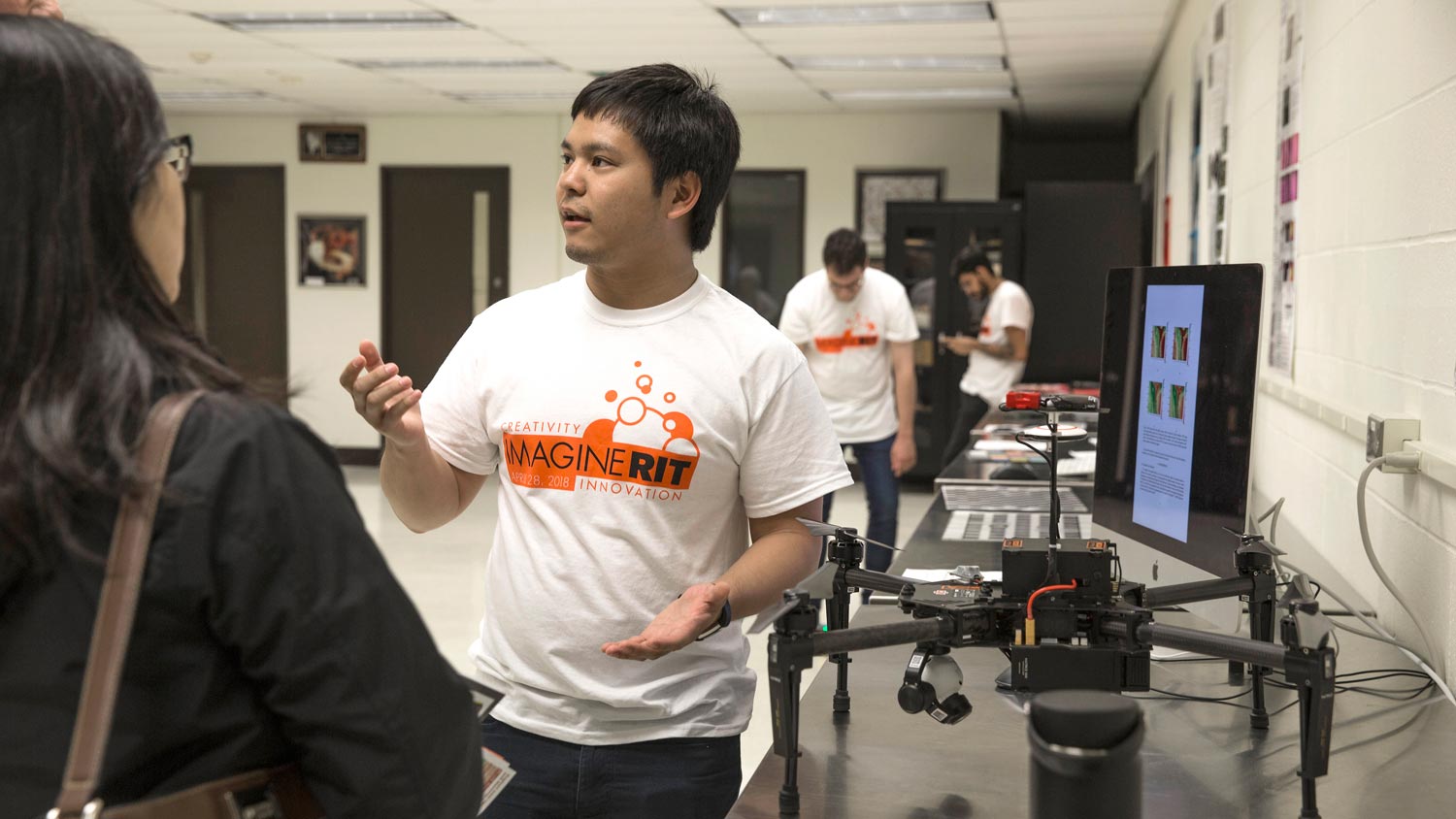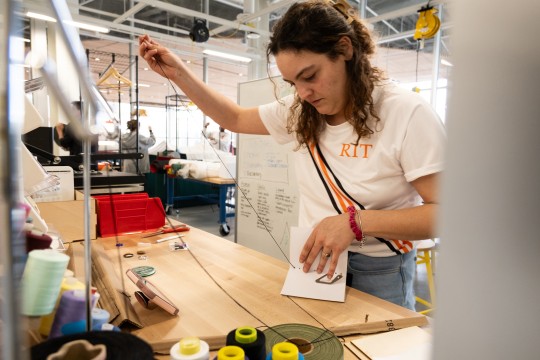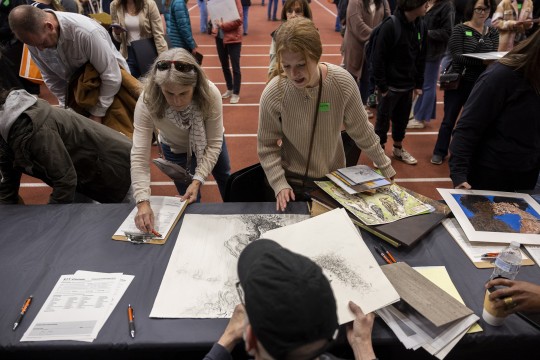Photographic Sciences Bachelor of Science Degree


Photographic Sciences
Bachelor of Science Degree
- RIT /
- Rochester Institute of Technology /
- Academics /
- Photographic Sciences BS
RIT's scientific photography degree immerses you in the fascinating world of scientific photography, where you’ll use photography to capture images and collect scientific data.
Overview for Photographic Sciences BS
Why Study Scientific Photography at RIT
- Photographic sciences is an RIT New Economy Major: This collection of degree programs is forward-thinking and future-forming, and helps prepare you to excel in the multidisciplinary nature of our modern, dynamic economy.
- Combining interests in both science and the arts: photographic sciences features unique coursework found at no other U.S. institution. Upper-division classes focus on high-speed photography, micrography, ophthalmic imaging, and image analysis/quality, among other topics.
- Industry Work Experience: Four required blocks of cooperative education and internship means nearly a year of hands-on, full-time paid work experience at organizations like the FBI, the Mayo Clinic, and Smithsonian Institution.
- Strong Career Paths: Carl Zeiss Microscopy and NASA are two of the biggest employers of our graduates. Other employers include Canon, Fujifilm, Leica Microsystems, and the National Retina Institute.
- Industry Exposure: Alumni, students, and faculty are regularly recognized by industry competitions like Nikon’s Small World and the BioCommunications Association’s BioImages competition.
Part scientist, part artist. A scientific photographer uses imaging to capture scientific data to explore science and medicine. These scientific images identify and solve problems–and help to advance our understanding–in biology and biomedical sciences, medicine, forensics, chemistry, and engineering. It’s a dynamic field that combines photography with imaging science, information technology, computing, optics, biology, and biomedical sciences.
RIT’s Scientific Photography Degree
RIT’s Bachelor of Science in Photography provides you with the broad-based skills required of a professional photographer, combined with a solid foundation in the sciences.
You’ll complete courses that develop your abilities as a photographer and gain the photographic skills and approaches required of scientific photography. In addition, you’ll study science and technology through the lens of photography, with courses in:
- High-speed photography
- Micrography
- Ophthalmic imaging
In the first two years, this scientific photography degree will immerse you in the technical applications of scientific photography. At the same time, you will pursue courses in laboratory sciences, including physics and biology.
The scientific photography degree provides you with the flexibility to use elective courses to explore areas that interest you and complement your career goals. You’ll be encouraged to use general education requirements to integrate complementary studies in subjects such as imaging science, information technology, or developmental biology to help prepare for exciting and evolving career opportunities.
You will graduate well-prepared to apply technological advances in photography to a wide variety of photographic and imaging careers and advanced degrees spanning the fields of science, technology, and medicine.
Photographic Sciences Student Association
The Photographic Sciences Student Association promotes professional and social interaction among students in the program and professionals from the imaging and photographic technology industries. The association regularly invites alumni and leaders from the professional imaging fields to present lectures and demonstrations.
Furthering Your Education in Photography
Combined Accelerated Bachelor's/Master's Degrees
Today’s careers require advanced degrees grounded in real-world experience. RIT’s Combined Accelerated Bachelor’s/Master’s Degrees enable you to earn both a bachelor’s and a master’s degree in as little as five years of study, all while gaining the valuable hands-on experience that comes from co-ops, internships, research, study abroad, and more.
+1 MBA: Students who enroll in a qualifying undergraduate degree have the opportunity to add an MBA to their bachelor’s degree after their first year of study, depending on their program. Learn how the +1 MBA can accelerate your learning and position you for success.
Next Steps to Enroll
From deposit to housing, view the first five steps for accepted first-year students.
Careers and Experiential Learning
Typical Job Titles
| Clinical Research Scientist | Field Support Engineer |
| Forensic Photographer | Forensic Specialist |
| Imaging Quality Engineer | Imaging Quality Assessor |
| Medical Photographer | Photomicrographer |
| Software Quality Assurance (SQA) Engineer | Image Quality Technician |
| Medical Image Technician | Ophthalmic Photographer |
| Surgical Photographer |
Industries
-
Biotech and Life Sciences
-
Health Care
-
Research
Cooperative Education and Internships
Hands-On Experience to Gain Real-World Skills
What’s different about an RIT education? It’s the career experience you gain by completing cooperative education and internships with top companies in every single industry. You’ll earn more than a degree. You’ll gain real-world career experience that sets you apart. It’s exposure–early and often–to a variety of professional work environments, career paths, and industries.
Co-ops and internships take your knowledge and turn it into know-how. Co-op in the College of Art and Design provides hands-on experience that enables you to apply your artistic capabilities in dynamic professional settings while you make valuable connections between classwork and real-world applications.
Students in the photographic sciences program are required to complete one co-op experience. These experiences are generally completed between the second and third academic years. Some recent co-op placements, as well as permanent job placements, include Harvard University, the Mayo Clinic, Smithsonian, Georgetown University, Case Western Reserve University, NASA, Imatest, Carl Zeiss Microscopy, FBI, Nikon Scientific Instruments, Apple Inc., and NVIDIA.
Scientific Photography Careers
With a 95% outcomes rate, you’ll be well-prepared to launch an exciting career in scientific photography. Our graduates are employed as ophthalmic photographers, forensic photographers, surgical photographers, photomicrographers, medical photographers, latent finger print examiners, core imaging facility managers, technical support engineers, imaging specialists, imaging engineers, public relations photographers, research associates, dermatology photographers, research photographers, and image quality engineers.
Recent employers include imaging companies, universities and research centers, camera companies, forensic laboratories, and government agencies. NASA, Apple, The Mayo Clinic, Carl Zeiss Microscopy, Harvard University, the National Geospatial Intelligence Agency, and Canon have all hired graduates of the program.
Creative Industry Days
Connect with Design Industry Leaders
RIT’s Office of Career Services and Cooperative Education hosts Creative Industry Days, which connects students majoring in art, design, film and animation, photography, and select computing majors with companies, organizations, creative agencies, design firms, and more. Creative Industry Days are a series of events that allow you to network with company representatives and interview directly for open co-op and full-time employment positions.
Featured Work
Capstone Research
For their senior capstone projects, students in RIT's photographic sciences major choose their own research topic to investigate over their final two semesters.
Senior Capstone
Each year, graduating Photographic Sciences students exhibit their senior capstone projects during a spring poster session. Based on their experiences in the program, students choose their topic in...
Microscopic Photos Honored
Teri Zgoda ’17
Teri Zgoda ’17 (Photographic Sciences) has become a regular honoree in Nikon’s annual Small World Photomicrography Competition.
Featured Profiles
Imaging Technologies Expert
After graduating, Paul Reichert '01 (Imaging and Photographic Technology; now Photographic Sciences) joined the Photography and Television (Photo/TV) Operations group at NASA Johnson Space...
Behind the lens of a scientific photographer
Teri Zgoda '17 (photographic sciences) is an award-winning scientific photographer whose images have been honored by Nikon and prestigious national magazines.
Optical Equipment Expert
As team lead of the remote advanced workflow specialist team for Leica Microsystems, Stefanie Nicolosi ’09 (Photographic Sciences) knows the ins and outs of optical equipment worth more than $1...
Curriculum for 2023-2024 for Photographic Sciences BS
Current Students: See Curriculum Requirements
Photographic Sciences, BS degree, typical course sequence
| Course | Sem. Cr. Hrs. | |
|---|---|---|
| First Year | ||
| PHAR-101 | Photographic Arts I This course will provide an immersive introduction to the field of the photographic arts. It will emphasize both craft and visual problem solving. The course will explore: seeing and appreciating the quality of light, image capture, photographic vision, historical and contemporary genres of photography, best practices and workflow as well as an introduction to the critique forum and its practices. (Co-requisites: PHPS-106 or equivalent course.) Critique 2, Lecture 1, Lab 3 (Fall, Spring). |
4 |
| PHPS-102 | Photography II This course is the second of a two-semester sequence of study further enhancing photographic practices. Emphasis is on improving photographic skills learned in Photography I. Skills include studio lighting, lighting on location, and macro photography. Principles of creativity, craftsmanship, and applied photographic theory will be used to support technical applications. (Prerequisites: PHPS-101 or PHAR-101 or equivalent course.) Lab 3, Studio 3, Lecture 2 (Spring, Summer). |
4 |
| PHPS-106 | Photographic Technology I The course Photographic Science Fundamentals will introduce the application of physics, mathematics, and optical science behind the processes of photography. The course also provides the students with the opportunity to employ statistical data analysis to identify trends through laboratory exercises utilizing principles of scientific inquiry. Lab 3, Lecture 2 (Fall). |
3 |
| PHPS-107 | Photographic Technology II This is the second course in a two-semester course based in the study of the technology of photography, with emphasis on applications to real world photographic problems. Among the topics studied will include color vision, Munsell color system, CIELAB system, color theory, color management, digital color balance during post-processing, digital tone reproduction, and digital workflows. (Prerequisite: PHPS-106 or equivalent course.) Lab 2, Lecture 2 (Spring). |
3 |
| YOPS-10 | RIT 365: RIT Connections RIT 365 students participate in experiential learning opportunities designed to launch them into their career at RIT, support them in making multiple and varied connections across the university, and immerse them in processes of competency development. Students will plan for and reflect on their first-year experiences, receive feedback, and develop a personal plan for future action in order to develop foundational self-awareness and recognize broad-based professional competencies. (This class is restricted to incoming 1st year or global campus students.) Lecture 1 (Fall, Spring). |
0 |
General Education – Ethical Perspective |
3 | |
General Education – Artistic Perspective |
3 | |
General Education – Global Perspective |
3 | |
General Education – Mathematical Perspective A** |
3 | |
General Education – Mathematical Perspective B** |
3 | |
General Education – First-Year Writing (WI) |
3 | |
| Second Year | ||
| FDTN-141 | 4D Design 4D Design introduces students to the basic concepts of art and design in time and space. The course explores elements of moving images such as continuity, still and moving image editing, transitions and syntax, sound and image relations, and principles of movement. Computers, video, photo, sound and lighting equipment are used to create short-form time-based work relevant to students in all majors and programs required to take this course. The course addresses the both historical conventions of time in art and recent technological advances, which are redefining the fields of Fine Art and Design. In focusing on the relations between students' spacing and timing skills, 4D Design extends and supplements the other Foundation courses, and prepares students for further work with time-based media. (Undergraduate Art and Design) Lab 5 (Fall, Spring). |
3 |
| PHPS-201 | Scientific Photography I The first course of a two-semester sequence that will develop photographic skills and approaches required in scientific photography. The course will develop scientific methods required for standardized imaging. Appropriate subjects including contact lenses, rice grains and other challenging, nearly invisible objects will be explored. Students will investigate unique illumination techniques in order to reveal a subject’s unusual characteristics. Techniques including polarized light and fluorescence reveal what cannot easily be observed without specialized photographic imaging and image processing. In addition, the course will expose students to ethical problems encountered in scientific imaging including managing and processing digital data. (Prerequisites: PHPS-102 or PHAR-102 or PHAR-161 or equivalent course.) Lab 3, Lecture 2 (Fall). |
3 |
| PHPS-202 | Scientific Photography II This is the second course in a two-semester sequence that explores new and different photographic skills and methods useful in scientific photography not covered in Scientific Photography I. Appropriate subjects will be explored in each of the various assignments designed to develop methods used in various scientific applications. Students will investigate new ways to reveal a subject's characteristics such as imaging with ultraviolet and infrared revealing what cannot be observed without photographic imaging and image processing. The course will expose students to the processes required to produce scientific research as well as scientific posters. (Prerequisites: PHPS-201 or equivalent course.) Lab 3, Lecture 2 (Spring). |
3 |
| PHPS-207 | General Education – Elective: Vision, Perception and Imaging (WI-GE) This course will explore the anatomical structure, function, and physiology of the human eye and brain and their relationship to vision, color, visual perception and imaging systems. The biology and physiology of the eye and psychology of visual perception will be explored. The concepts of depth perception in human vision as they relate to both two-dimensional and three-dimensional contexts will be examined. Relationships of image brightness, contrast and how visual processes lead to seeing will be addressed. Lecture 3 (Spring). |
3 |
| PHPS-211 | Photographic Optics This required course will investigate advanced photographic technology, with an emphasis on the study of the components of photographic imaging systems. Geometrical optics, color management, printing technologies and video standards will also be studied. Working in a lab environment, students will evaluate how technology can be optimized and where its limitations might be found. (Prerequisites: PHPS-107 or equivalent course.) Lab 3, Lecture 2 (Fall). |
3 |
| PHPS-217 | Media Production & Technology Media Technology explores the design, production and delivery of instructional media and marketing materials used in various industries. Students will plan and produce the content for media projects that integrate video, audio, still images, interactivity, two-dimensional animation and video. The course also explores the technology and production techniques involved in delivering digital content today. Additionally, the course will provide an introduction to basic instructional technology concepts that influence design, development and assessment decisions. The focus of classwork will be the production of media used in support of training and marketing activities commonly found in corporate, governmental, industrial, and scientific communities. (Prerequisites: FDTN-141 or equivalent course.) Lab 3, Lecture 2 (Spring). |
3 |
| PHPS-499 | Photographic Sciences Co-op (summer) Cooperative Education will provide photographic and imaging technologies students with hands-on experience in their field, directly related to a student’s major with an established studio or related business. Students will need to apply for co-ops, and interview as part of the selection process, based on available positions posted by the Co-op and Career Services Office, or found through the students’ own research. In programs where co-op is a degree requirement, students must obtain permission of their program or graduate director prior to enrollment. Co-ops are typically paid work experience, and can be part-time (150-479 total hours within the term), or full-time (480+ hours within the term). Co-ops may be one or two consecutive terms - fall, spring, or summer – with department permission. (This course is restricted to students in PHIMTEC-BS.) CO OP (Fall, Spring, Summer). |
0 |
General Education – Elective |
3 | |
General Education – Social Perspective |
3 | |
General Education – Natural Science Inquiry Perspective |
4 | |
General Education – Scientific Principles Perspective |
4 | |
| Third Year | ||
| PHPS-331 | Programming for Photographic Sciences This course will introduce students to programming as a data visualization tool and a programming language (Python). Students will learn the various capabilities of the language and how it can be used to rapidly prototype solutions to various imaging-related problems. As these solutions are developed, fundamental concepts of programming and data structures will be introduced. (Prerequisite: PHPS-211 or equivalent course.) Lab 3, Lecture 2 (Fall). |
3 |
| PHPS-332 | Digital Image Processing This course covers the principles and fundamental techniques in writing digital image processing algorithms and computer programming techniques that are used in implementing said algorithms. Topics covered will include color space transformations, basic image manipulation, and spatial and frequency manipulations. (Prerequisite: PHPS-331 or equivalent course.) Lab 3, Lecture 2 (Fall, Spring). |
3 |
Professional Electives |
6 | |
General Education – Elective (Choose from STEM Elective list) |
4 | |
General Education - Elective |
3 | |
General Education – Immersion 1, 2 |
6 | |
Open Electives |
6 | |
| Fourth Year | ||
| PHPS-401 | Photographic Sciences Capstone I (WI-PR) This course is the first of a two-term sequence designed to begin work on a major student project. The topic will relate to an aspect of the photographic sciences, including but not limited to photomicrography, image testing and quality, ophthalmic imaging, color, or other relevant topics. In this course, students will conceive and design a long-term project or experiment, including a proposal, description, goals, timeline, resources, and funding (if necessary). The student will work to construct and refine the proposal, and will identify a faculty advisor if needed for the execution of the project in PS Capstone II. The class sessions will focus on project planning and provide in-progress discussion of proposals.
The project will be completed during the second semester (PHPS 402 – Photographic Sciences Capstone II). Projects will be student initiated within an individual’s area of expertise. Completed projects will constitute a substantial portfolio/professional project. (Prerequisites: PHPS-202 or equivalent course and completion of First Year Writing (FYW) requirement.) Lecture 3 (Fall). |
3 |
| PHPS-403 | Photographic Sciences Capstone II Students will execute a major project proposed in the first course of the sequence: PS Capstone I. Projects may address subjects related to the photographic sciences or other relevant topics. Students will provide a progress report to the course coordinator at set intervals. Class will meet weekly to provide discussion and feedback on individual projects. (Prerequisite: PHPS-401 or equivalent course.) Lecture 3 (Spring). |
3 |
General Education – Immersion 3 |
3 | |
General Education – Electives |
6 | |
Open Electives |
9 | |
Professional Electives§ |
6 | |
| Total Semester Credit Hours | 125 |
|
Please see General Education Curriculum (GE) for more information.
(WI) Refers to a writing intensive course within the major.
Please see Wellness Education Requirement for more information. Students completing bachelor's degrees are required to complete two different Wellness courses.
§ Please see an advisor for a complete list of photographic sciences electives.
** Please see an advisor for math and science course recommendations.
Admissions and Financial Aid
This program is STEM designated when studying on campus and full time.
First-Year Admission
A strong performance in a college preparatory program is expected. This includes:
- 4 years of English
- 3 years of social studies and/or history
- 3 years of mathematics which must include algebra, geometry, and algebra 2/trigonometry. Pre-calculus is preferred.
- 2-3 years of science. Biology is preferred.
Transfer Admission
Transfer course recommendations without associate degree
Courses in liberal arts, photography, design, and art history. Portfolio required for photo credit. View Portfolio Requirements for more information.
Appropriate associate degree programs for transfer
Applied Photography. Portfolio required for photo credit. View Portfolio Requirements for more information.
Financial Aid and Scholarships
100% of all incoming first-year and transfer students receive aid.
RIT’s personalized and comprehensive financial aid program includes scholarships, grants, loans, and campus employment programs. When all these are put to work, your actual cost may be much lower than the published estimated cost of attendance.
Learn more about financial aid and scholarships
Latest News
-
March 21, 2024
![A student binds a book in the textile makerspace in the SHED.]()
Innovation unleashed: students forge transdisciplinary projects at RIT's a2ru summit
Students leveraged the variety of makerspaces in RIT's brand-new SHED facility to create arts-integrative work responding to a theme of "Play."
-
February 26, 2024
![Athena Lemon and Joshua Rashaad McFadden appear on Good Day Rochester]()
RIT student ignites discussion on disparities in black history with photographic exhibit
FOX Rochester talks to Joshua Rashaad McFadden, assistant professor for the School of Photographic Arts and Sciences, and Athena Lemon, fourth-year individualized program student, about the exhibit.
-
November 6, 2023
![A student has her artwork reviewed by faculty member Don Arday.]()
Prospective students explore RIT art and design programs at National Portfolio Day event
The College of Art and Design welcomed 226 young artists to campus for its National Portfolio Day event, where prospective students met one-on-one with faculty about their artwork and different programs.



























